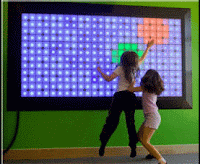The annual Capstone conference showcases research by graduating occupational therapy students of the University of British Columbia’s Department of Occupational Science and Occupational Therapy. Research is conducted in the year leading up to the conference and is as diverse as the occupational therapy itself. Two student groups researched virtual rehabilitation topics in the 2009 – 10 year.
Is Nintendo Wii Feasible and Usable for Pediatric ABI Rehabilitation?
Students: Shannon Rolph, Tristan Thomas
Supervisor: Dr. Tal Jarus, S. Jagday, Dr. Debbie Rand
www.capstoneconference.ca/index.php?option=com_projects&view=project&id=10&Itemid=5
Rationale: The functional ability of children with acquired brain injury (ABI) is often limited, and as such clinicians are always exploring new tools for rehabilitation with this population. The Nintendo Wii (Wii) is an inexpensive, accessible and fun gaming system that is emerging as a popular tool in rehabilitation. To this point, some research has examined outcomes using the Wii as a rehabilitation tool, however at this point the fundamental feasibility and usability of the Wii for this population has not been determined.
Objectives: 1) To determine the feasibility and usability of the Wii for children with ABI; 2) to characterize the children’s experience while using the Wii; 3) To compare the experience of children with ABI to the experience of healthy children.
Methods: Fifteen children with ABI and fifteen healthy children, ages six to nineteen, will be recruited from a rehabilitation centre and the community, respectively. Participants will experience three Wii games. Feasibility will be determined based on participants’ game performance. For children with ABI, their motor and cognitive abilities will be measured using a battery of reliable and valid assessments. This information will be correlated with game performance to determine feasibility based on motor and cognitive abilities for children with ABI. Usability will be determined based on the System Usability Scale, administered after participants operate the Wii. The Short Feedback Questionnaire-CHILD and the Borg Scale of Perceived Exertion will obtain participants’ feedback regarding their Wii experiences. Accelerometres will measure the movement elicited while playing the Wii. This data will be compared between healthy and ABI groups.
Clinical Implications: The study’s findings will allow clinicians to determine if the Wii is a feasible and usable rehabilitation tool for children with ABI, based on their client’s cognitive and motor abilities.
EyeToy vs. Wii
Students: Shereen Ens, Ashea Neil, Bobbi Pelletier
Supervisors: Dr. Tal Jarus, Dr. Debbie Rand
www.capstoneconference.ca/index.php?option=com_projects&view=project&id=7&Itemid=5
Introduction: Virtual reality (VR) is an emerging trend in stroke rehabilitation. Research shows virtual reality gaming consoles in stroke intervention can increase motivation, enjoyment and movement during exercise, while giving a heightened sense of presence. To date, there is little research on the amount and intensity of movement elicited using these systems during rehabilitation.
Objectives: Within healthy and stroke populations 1) Compare amount and intensity of movement elicited from both hands while playing Nintendo Wii versus Sony Playstation 2 EyeToy; 2) compare experiences of both groups using both systems; and 3) compare usability of both systems.
Methods: A cross-sectional design was taken. Participants included ten adults who had experienced stroke at least six weeks prior to study and were medically stable, and a convenience sample of ten healthy adults. Participants experienced two games from each console. Amount and intensity of movement was measured using accelerometers on both wrists, while the virtual experience and usability was determined with questionnaires.
Results: No significant differences were found between the systems usability and experience; however stroke participants rated EyeToy easier to use (44.40±5.06 vs. 39.30±6.93). EyeToy elicited significantly greater activity count than Wii among the healthy participants (p=0.028) and significantly greater movement intensity in both the stroke (p=0.005) and healthy (p =0.005) groups.
Conclusion: Both VR systems rated high for usability, enjoyment and satisfaction highlighting their suitability for a range of abilities in stroke rehabilitation. EyeToy as a rehabilitation tool provides increased movement and movement intensity.




